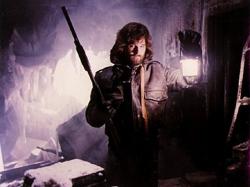
An underrated aspect of practicing and performing in extreme music is posture. This is for a number of reasons, namely that live, metal musicians are usually too busy… going apeshit (hopefully) to worry about how their body is arranged.
But achieving a comfortable physicality is important, and often what we call “stage presence” has to do with a band being loose. As I’ve discussed before, it’s difficult for a band to make a connection with an audience if they’re on-edge – always worrying about playing their parts right, their muscles tensed up like a maxed-out pre-amp, focusing more on their engagement with the instrument than on their mind and heart’s engagement with the material. Your goal should be to remove every tension in your body such that, in a sense, you disappear; eliminating the physical boundary between what you feel and what you play.
Good posture starts with watching what other musicians do. Someone I really admire is the jazz guitar prodigy Pasquale Grasso. If you pay attention to the below video, you’ll see that he’s playing some pretty fast, complicated shit. But his picking hand is barely moving (video audio is super low, so make sure to turn your speakers down after watching).
Classical and jazz musicians focus far more on posture than those who play rock and metal (comfort is in some ways more necessary for those musics than in metal), and as a result are much better at things like improvisation, rhythm, and chordal comping.
Someone who, despite my feelings about their ability to listen to certain musicians, has learned from older styles of guitar picking is Marty Friedman. It shows not just visually, but in how fluid and expressive his playing is. Even if you’re not a fan of his, you should study his picking technique. Note how the tension at the crux between his elbow and the body of the guitar is eliminated by a more natural, relaxed position.
Another musician with tremendous posture is Billy Rymer of The Dillinger Escape Plan. Despite playing in a band that requires (easily) the hardest drum parts in the business, Billy’s playing is completely at ease. Watching him is like watching four snakes play the drums – everything is natural, nothing is ever forced. Although I love Chris Pennie’s playing on Miss Machine, you can hear the moments when he struggles to complete certain parts. His body is much tighter, the sticks always excessively close to the point of contact. Billy is fluid like a jazz drummer, and brings to the band the kind of loose-yet-composed feel that the music requires. Check out this fan-shot drum lesson in which he discusses his arm technique:
The lesson to take away from watching guys like this is that you need to find comfort on your own. Play something easy – like a major scale – slowly, and focus on every point of tension in your body. Pay attention to where something feels slightly uncomfortable, and try and shift it. Whatever requires the least amount of energy is what you need to chase. Even if that comes at the expense of certain speed barriers you’ve broken, that’s good, because you will never break through speed barriers if they are ultimately going up against an insurmountable wall of discomfort.
Achieving comfort on your instrument is one of the most difficult, long-term projects that you need to practice. But by starting early, you put yourself in a good position down to the road to be faster and more efficient on your instrument. And most importantly, it will allow you to think less about what your body is doing and more on what your being wants to communicate through sound.





Bryano / December 8, 2015 12:10 pm
I play with an A frame on my guitar (I follow the guidelines for classical position) but forgot it at home before practicing at work and basically can’t play without it anymore. I don’t understand how anyone can get the higher frets with a guitar positioned at 90 degrees.
/